Cheap synthetic rugs. What you need to know.
It used to be, about a decade ago, that if you wanted to buy a rug you went to a rug store. And odds are, you’d walk away with a wool rug.
Wool is the best fiber on the planet for rugs. It’s strong, dyes up vividly, always washes up beautifully, and lasts and last and lasts.
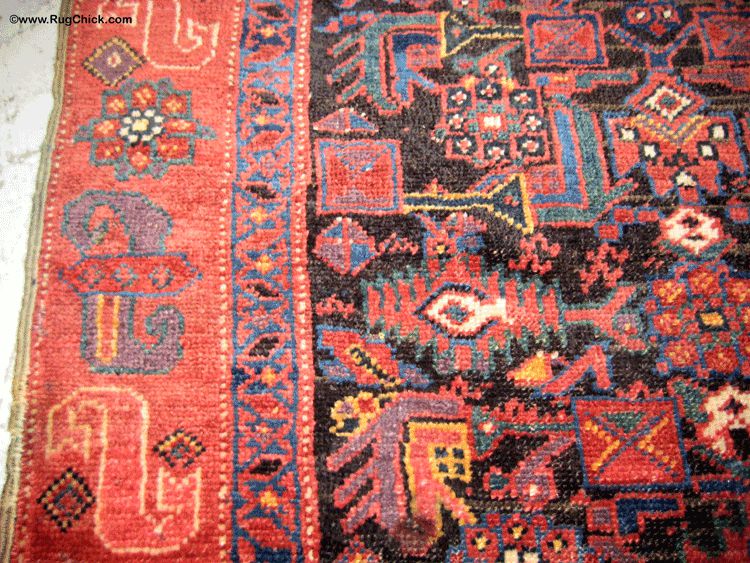
NW Persian hand woven wool rug (pre-1800) still looks fantastic!
Even the lesser quality wool rugs from a decade ago, perhaps the ones more heavily chemically processed from China, still would last you decades. So your choice back then was great investment wool rugs (sold at Rug Galleries) and not-so-great commodity wool rugs (perhaps the ones being sold at Home Depot Expo).
But still, if it was wool, it was worth owning back then.
Today it’s a whole different ballgame. And the market is flooded with SYNTHETIC area rugs.
The synthetic fibers, olefin (aka polypropylene), polyester, and acrylic, are being used to create “FAKE” wool rugs… but as you can see side by side, it’s like putting particle board next to real wood:
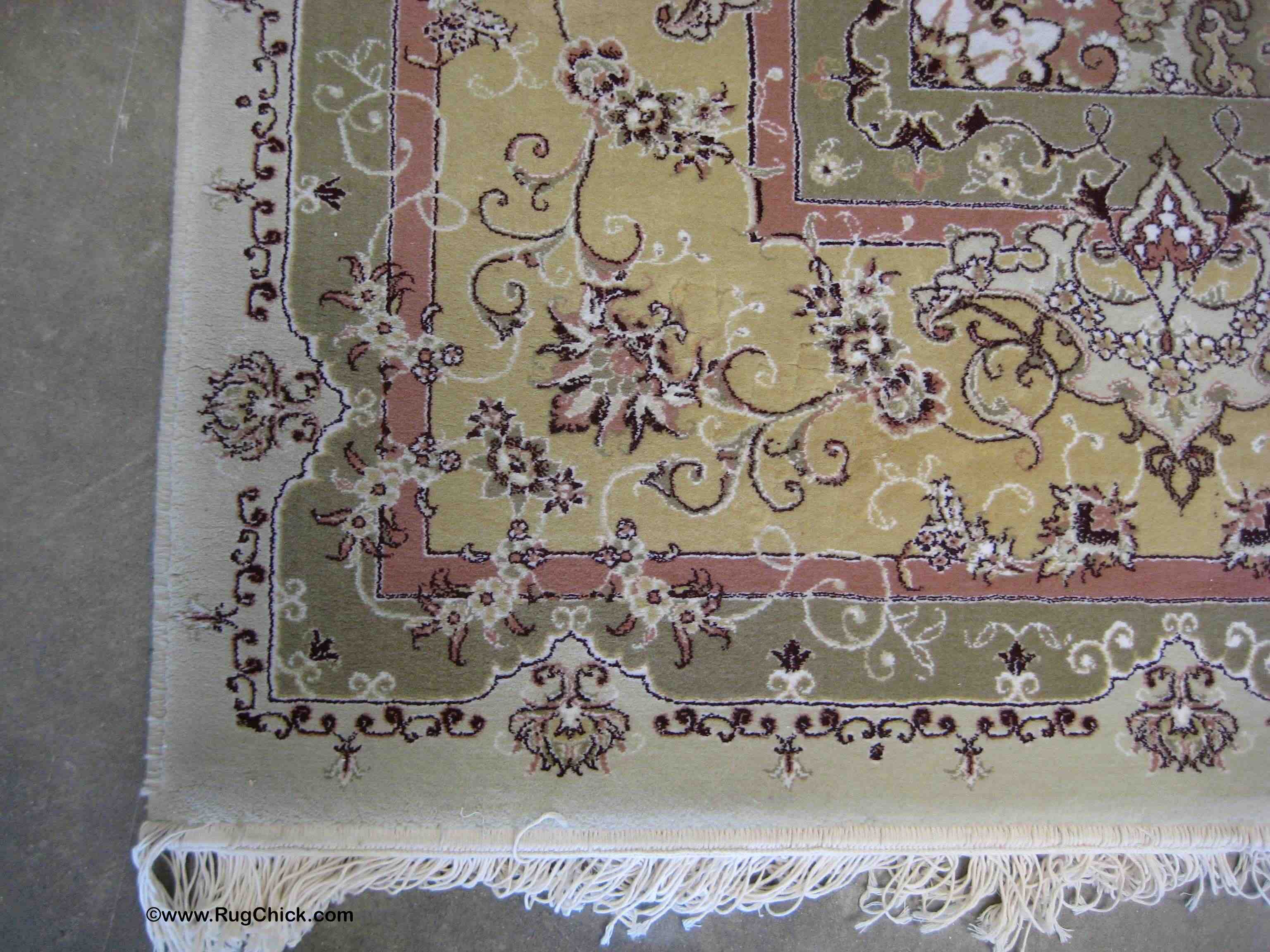
FAKE on left (acrylic)
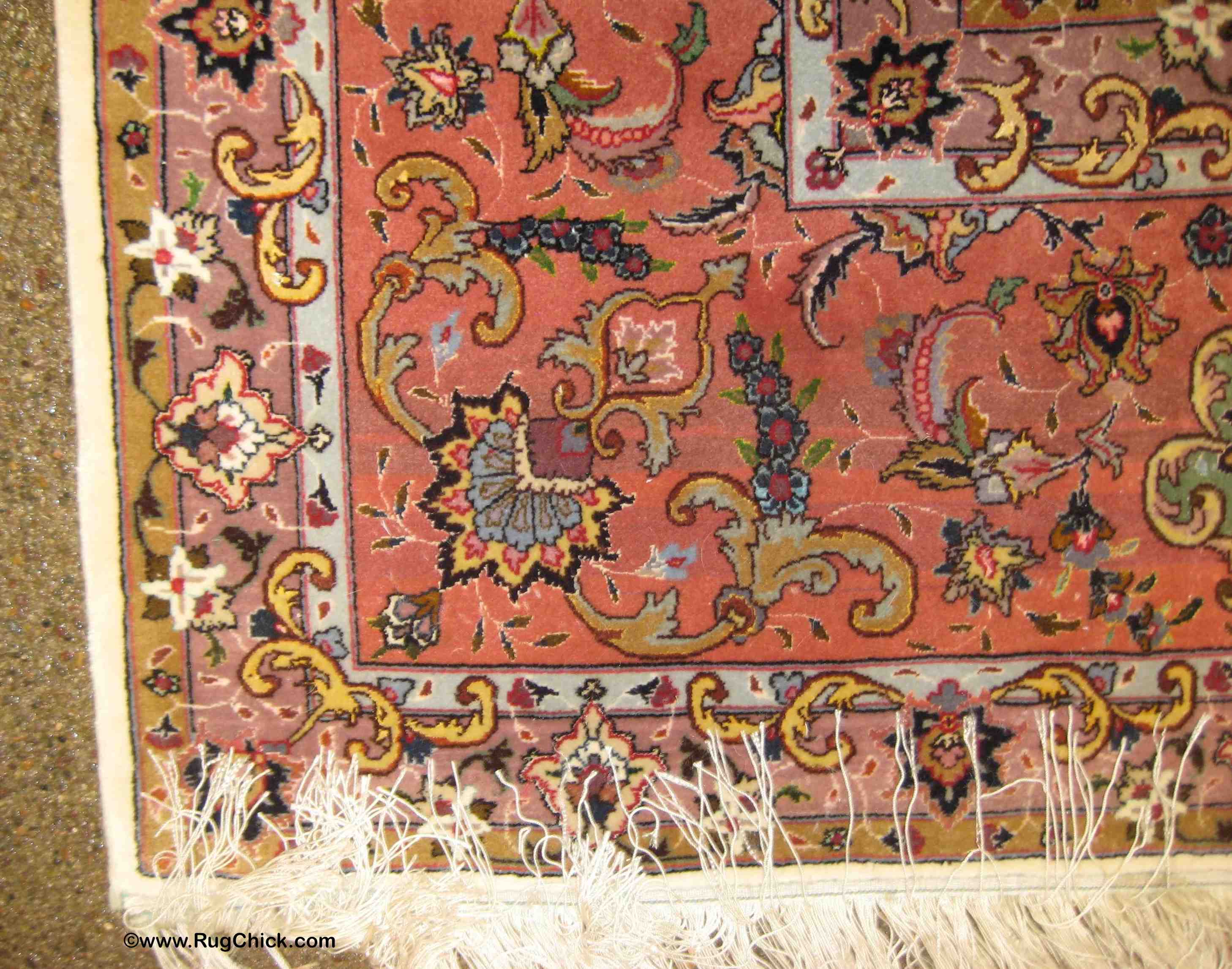
REAL on right (wool).
Now, some might think it is great that we now have a lot of inexpensive synthetic area rugs on the market. These people would be wrong, because the low cost rugs end up having a high cost that the buyers need to be aware of…
…because the sales people are not going to tell you this.
Pros and Cons of Today’s SYNTHETIC Fiber Area Rugs
PROS:
1. They are cheap.
If you pay more than $5 per sq ft for a synthetic olefin (polypropylene) or polyester or acrylic rug, you are being RIPPED OFF. You should truly pay next to nothing for these rugs because there is no labor cost in their production (all are machine made) and the fibers are essentially poor quality plastic.
This is basically the big “pro” of these rugs, that they are cheap.
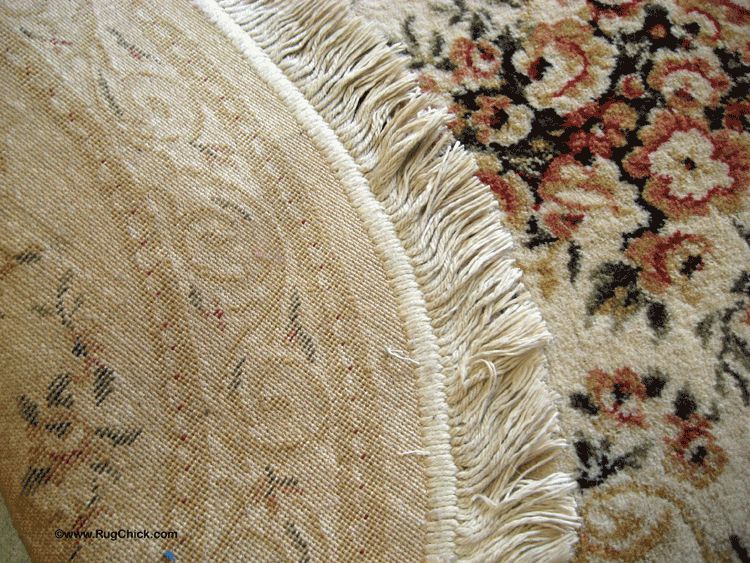
The back of olefin rugs are hard to the touch – they feel like plastic because they are plastic.
CONS:
1. They require MORE cleaning.
The great thing about wool is that those fibers have lots of “pockets” in its construction to hide dust and grit, so they look good even when they are dirty.
That is NOT the case with olefin, polyester, and acrylic, which are plastic fibers and solid and smooth strands. This means there is no place to “hide” soil so it simply sticks to the outside of the fibers, and these rugs get duller, and uglier faster as a result. This means you will want to clean your synthetic rugs after months on the floor rather than after a year or two with your wool rugs. Synthetic rugs get ugly faster.
Because they are synthetic, if there are no issues like pet urine or flood exposure contamination, they can be surface cleaned with Hot Water Extraction (aka “steam cleaning”) and can be cleaned using more aggressive cleaning solutions than can be used on wool.
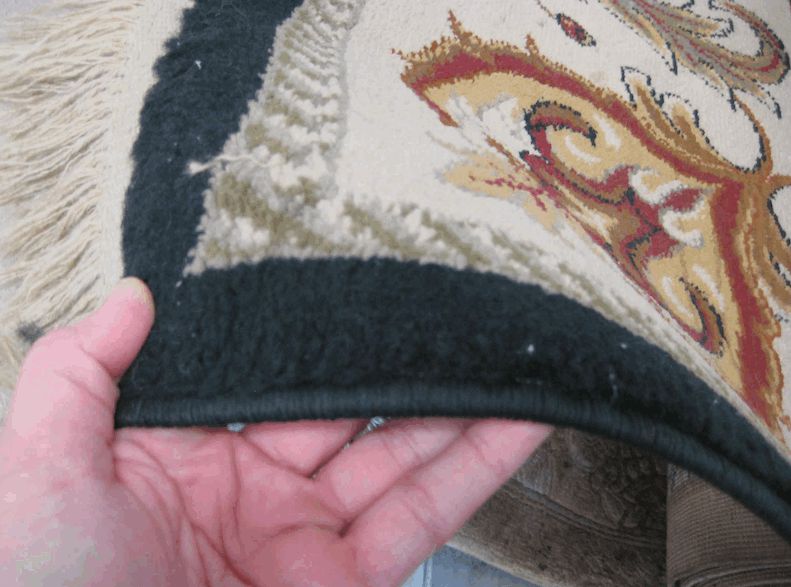
“Blah” looking acrylic rug. Flat colors. Texture looks like a sponge.
2. They wear and yellow faster.
Because they are plastic, they do not have longevity, and do not wear well with abrasion. In fact, most wall-to-wall carpet in commercial buildings is installed olefin carpet (because it’s CHEAP!). So the next time you are in a commercial building take a look at the entryways and high traffic areas of their carpet, and you will see how worn down that carpet gets after only a few years.
By the way, home improvement stores often carry olefin (polypropylene) carpet for homes (because it’s CHEAP!), but this is the absolute worst fiber to have for residential homes because it simply does not hold up to foot traffic. Look for nylon instead if you want synthetic fibers for your wall-to-wall carpeting.
Olefin, polyester, and acrylic can get worn after just a few years on the floor.
3. They are STICKY and SCRATCHY. (Regular vacuums will not help you.)
The most maddening thing about these cheaper synthetic rugs for their owners, and for the professional cleaners who are asked to clean them, is that they grab everything and are tough to get to release lint, hair, and grime.
These new synthetic shag rugs being sold by stores like Pottery Barn, are next to impossible to get looking super clean because professional cleaners need to literally try to “pull away” what washing does not release row by row. This construction type also cannot be surface cleaned with today’s tools, so sometimes you get rugs that require much more labor to clean, sometimes exceeding what was paid for the rug in the first place. to buy it
With shorter pile synthetic fiber area rugs, you will be tempted if you own one to just get a lint roller to try to roll up the stuff sticking to the fibers that your vacuum cleaner cannot pick up. It’ll use a lot of lint roller sheets though. =)
The only vacuum cleaners I’ve seen effective at getting lint and pet hair off of these types of rugs are the Sebo vacuum cleaners, which are fantastic, and powerful, German made machines, but also not a cheap machine in order to vacuum up a cheap rug.
They also, because they are plastic, are not super soft to the touch. They aren’t rugs that feel great when you walk on them barefoot, and kids certainly are not going to want to roll around on them.
4. They often have JUTE foundations. (If you have PETS, you will hate this fact.)
If you have pets that are not properly trained, you will have a problem with synthetic rugs not because of the plastic fibers. Actually, olefin fibers though they ugly with grime, they are pretty much stain proof. But these plastic fibers are often wrapped around jute.
Jute is an absorbent plant fiber that looks like straw:
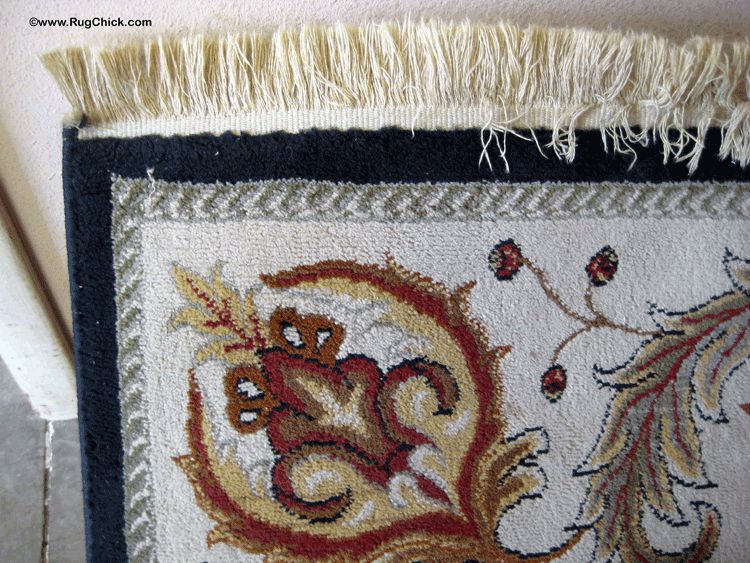
Front corner of synthetic rug.
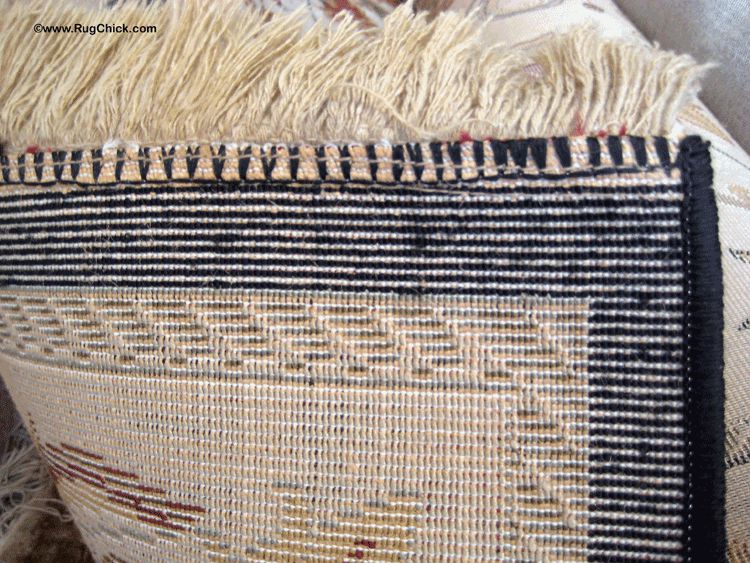
Back corner of synthetic rug, see the thick beige jute wefts.
Because nothing can penetrate the olefin fibers themselves (they have no “pockets”), there would technically be nothing to “hold” the odor in them…
…but the jute is another story entirely. And being thick compacted jute fibers, they hold odor like no other fiber can. They are the king of odor-holding fibers!
This means if you have any odor issues with synthetic rugs, you have two choices: one, to know that you will have to likely pay quite a bit more to clean and deodorize your rug by having it thoroughly washed than you paid for the rug to buy it; or, two, go buy another one and hope your pet does not repeat the problem.
Again, if the synthetic rug just is “dirty” and dull looking, it can be surface cleaned with hot water carpet cleaning equipment and chemicals. But if there are ODOR issues, or exposure from a FLOOD, the rugs need to be fully washed and deodorized – or simply replaced if that is the cheaper and easier option.
(FYI: With hand woven rugs, removing odors is not a problem. A proper wash process thoroughly removes the contaminants from urine exposure or flood exposure from wool and cotton fiber rugs.)
5. They are petroleum products, so they are not sustainable resources.
These plastic fibers are made from petroleum. There are some people who are not aware that synthetic fibers are plastic. They may not want to own them due to political, or environmental, or perhaps health reasons.
What’s nice about wool is that it’s a renewable resource…
…it grows back year after year to be sheared.
6. You will never say “WOW” after these synthetic rugs are cleaned.
What’s great about being a cleaner of wool rugs is that there is always a “wow” between when a client brings it in dirty, to when it is clean again.
One of the drags about having more synthetic rugs on the market today is that often the buyers of these rugs are not aware they are synthetic, and after they pay good money for a good cleaning, the “after” look of the rug is better but never a “wow.”
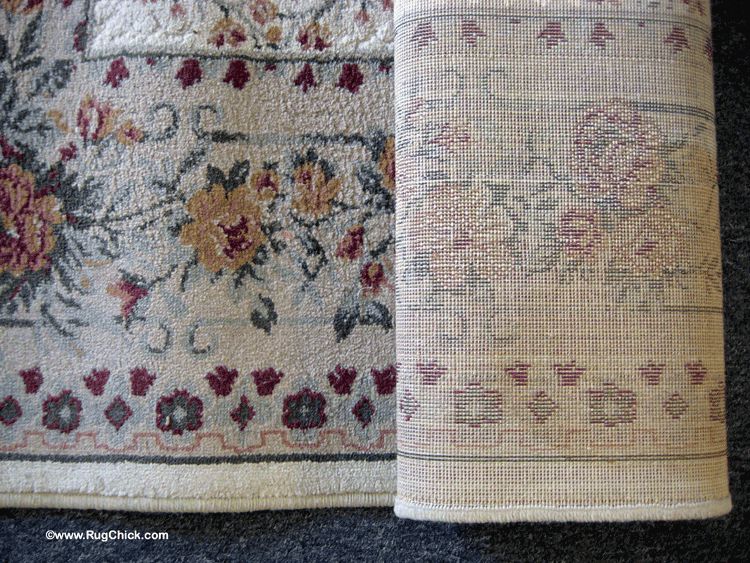
Olefin (synthetic) area rug. It’s never going to look great.
DISPOSABLE rugs vs. ENJOYABLE rugs
When I was growing up in our rug gallery business, the two groups of rugs we had were “investment” and “decorative” rugs.
I was surrounded by antique and semi-antique works of woven art in our gallery. I was always amazed by the stories of how these rugs were literally knot by knot crafted by hand over months, and sometimes years, of weaving.
Today the rug market has been overridden by a lot of really bad product. There are cheap synthetic rugs, and cheap wool tufted rugs, all basically considered “disposable” rugs. The synthetic ones, because of the problems I’ve noted already, and the tufted rugs because of the growing problem with the latex holding them together. The landfills are slowly being filled with these rugs that only last a few years.
There are however, still “enjoyable” REAL rugs out there. WOVEN rugs. Rugs with a part of a weaver’s heart and soul added to the strands.
You might think that to buy a woven rug will set you back financially, but there is actually good quality new woven wool rugs at very affordable prices available. There also are MANY hand woven wool rugs available second hand also at prices much lower than they should be. Home styles change, people move, and rugs need to be sold or given away. (It is a great time today to be a rug buyer, but not so great to be a rug seller.)
It basically all comes down to this regarding synthetic fiber area rugs…
…if you need a rug that you don’t want to worry about, you could care less about the look because you are using it for a floor-covering rather than as a decorative addition to your home, and you know you will replace it in a few years – then buy a synthetic rug. (Or perhaps a wool tufted one if you want something that hides soil better than olefin.)
I have both in my house. A few small tufted wool rugs, and a few olefin mats, literally being used as door entry rugs because I did not want feet being wiped off on hand crafted woven rugs… that just seems disrespectful even though a wool woven rug could take it very well. Wool woven rugs are tough.
When I look at a hand woven rug though I see a piece of a weaver’s life in front of me…
,,,so I don’t like wiping my feet on it. =)
And with that, you know more than you probably wanted to about today’s synthetic fiber area rugs.
If you are a consumer, you know whether a synthetic rug is what you really want and need. (You can read up on more rug buying tips if you feel like you want to find “real” rugs to purchase, and if you plan to buy a rug from Pottery Barn, you can see what is good and what is not.).
If you are a rug cleaner, you probably already know some of the challenges being presented to us in the field today with these specific synthetic rugs, and perhaps this post can help you explain these situations better to your clients who own them.
Happy Rug Cleaning!
– Lisa
